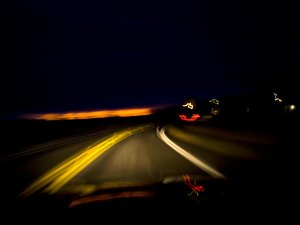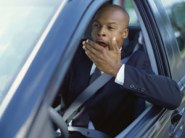 Some people enjoy driving at night, while some hate the idea… with good reason. Fatalities on the road occur at a rate three times greater at night than during the day, according to the National Highway Traffic Safety Administration (NHTSA). While only a quarter of all driving is done at night, more than half of all driving deaths occur then.
Some people enjoy driving at night, while some hate the idea… with good reason. Fatalities on the road occur at a rate three times greater at night than during the day, according to the National Highway Traffic Safety Administration (NHTSA). While only a quarter of all driving is done at night, more than half of all driving deaths occur then.
Three different factors usually combine to make these deadly figures what they are: fatigue, alcohol and poor visibility.
 Fatigue is a killer on the road, you should take your drowsiness very seriously. That split-second you have to react could be the difference between life and death. If you are feeling sleepy, take as few risks as possible. Driving for 12 hours or more without sleeping is about as bad as driving drunk, so it’s better to make stops, stretch, drink a cup of coffee. The NHSTA estimates falling asleep at the wheel is responsible for at least 100,000 automobile crashes, 40,000 injuries, and 1,550 fatalities every year. If you really must complete your journey, pull up to a rest area and take a 20 minute nap.
Fatigue is a killer on the road, you should take your drowsiness very seriously. That split-second you have to react could be the difference between life and death. If you are feeling sleepy, take as few risks as possible. Driving for 12 hours or more without sleeping is about as bad as driving drunk, so it’s better to make stops, stretch, drink a cup of coffee. The NHSTA estimates falling asleep at the wheel is responsible for at least 100,000 automobile crashes, 40,000 injuries, and 1,550 fatalities every year. If you really must complete your journey, pull up to a rest area and take a 20 minute nap.
Alcohol. Police have been aggressively targeting drunk-drivers everywhere, but unless they install scanners in every car, alcohol will continue to be a big problem. More deadly car crashes take place on weekend nights when people have been to the pubs than at any other time of the week. You might not have been drinking, but that other guy…
Visibility is the biggest problem when driving at night. Car headlights only allow us to see a small portion of the road ahead. We’ve found that headlights even in brand-new cars are sometimes uneven or pointed lower than necessary. So it’s worth the effort to aim them correctly. If you do it yourself, use the instructions in your owner’s manual. And be patient. It may take a few tries before you have them pointed perfectly. Just make sure those newly aimed lights are not blinding oncoming traffic.
Even lights that are aimed correctly can cast a dim glow if something is blocking the light, so be sure to clean the road grime from your headlights often. If you have an older car with plastic lens covers, those covers might have yellowed or faded over the years. The best fix is to buy a headlight polish kit to remove the haze so your lights shine through brightly. In clear weather, your headlights should allow you to see for about 100 meter or about 350 feet.
These artificial lights also dull our vision and decrease the sharpness of peripheral sight. Some people may also experience a warped perception of distance or shape. If you do, you might want to consult an eye doctor.
Here are a few other things to keep in mind:
- Dim Your Instrument Panel and Dash Lights. Cars come with dashboard dimmer switches for a reason. If you’re driving around with the dash light on max, you could be compromising your forward vision. Racers take the nighttime driving very seriously—in fact, endurance racers and rally drivers cover their dashboards with black felt to avoid stray reflections. While you shouldn’t do that in a road car, we like to turn down the dash brightness quite a bit.
 Become a Retina Spotter. On dark country roads, animals are everywhere. An encounter between wildlife and your car can be devastating—to you, the beastie, and certainly your vehicle. But here’s a trick: You can often see the reflections of your headlights in an animal’s eyes long before you can see the animal itself. Pairs of tiny bright spots in the distance are a clear warning that an animal is in front of you down the road. The best strategy when encountering large animals like deer: Slow down as quickly as you can. If you try to steer around a deer, they often will follow your lights and move in front of you.
Become a Retina Spotter. On dark country roads, animals are everywhere. An encounter between wildlife and your car can be devastating—to you, the beastie, and certainly your vehicle. But here’s a trick: You can often see the reflections of your headlights in an animal’s eyes long before you can see the animal itself. Pairs of tiny bright spots in the distance are a clear warning that an animal is in front of you down the road. The best strategy when encountering large animals like deer: Slow down as quickly as you can. If you try to steer around a deer, they often will follow your lights and move in front of you.
- Limit your speed and have good lane discipline. Just because you haven’t seen a car for a couple of minutes doesn’t mean you should clip corners, skip lanes or cut across on mountain roads.
- If there is another driver coming towards you, keep your headlights on low beams so you don’t blind them. If he fails to do the same, the best thing you can do is look at the right side of the road and use that to steer the car.
- If you’re attempting a long trip at night, make plenty of strops along the way at gas stations. The light will trick your body into waking up a bit, while coffee can keep you awake for a couple of hours. Light exercise is always a must to get blood going and reduce fatigue in joints.
Lastly, if something happens to your car or if you do have an accident, try to pull off the road completely. Turn the warning flashers on and the dome light. Place the reflectors or flares on the right side of the road and if possible get everybody out of the car and well away from the road. You wouldn’t believe how many trucks end up ramming cars that are stopped on the side of the road.
Safe driving!
JBA Chevrolet
7327 Ritchie Highway
Glen Burnie, MD
443-763-5076
Facebook | Twitter | Google+ | foursquare | Pinterest
